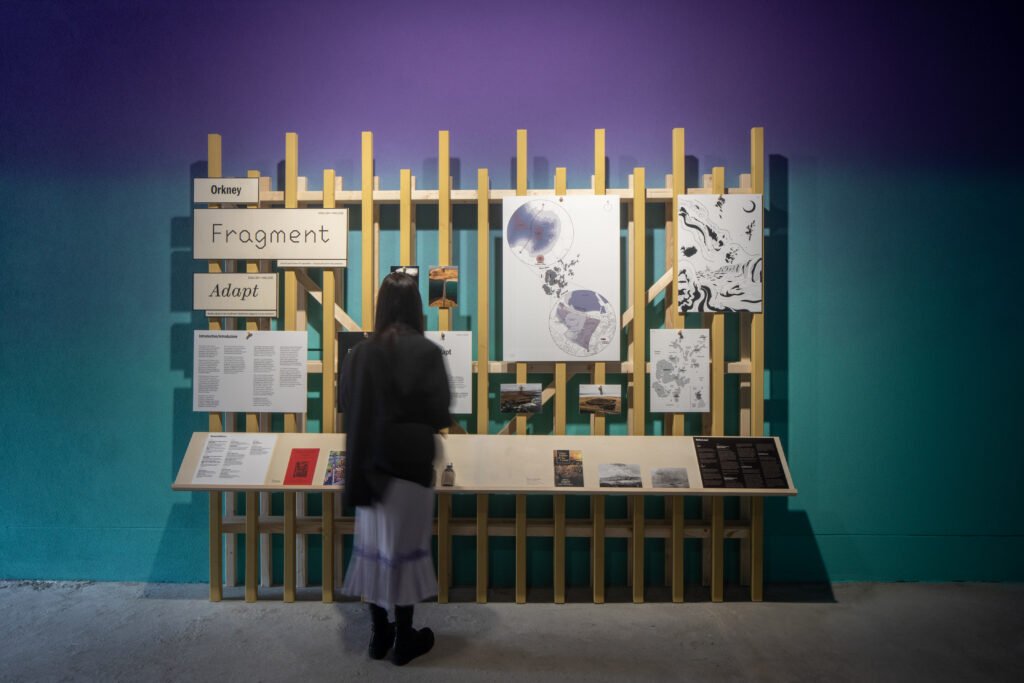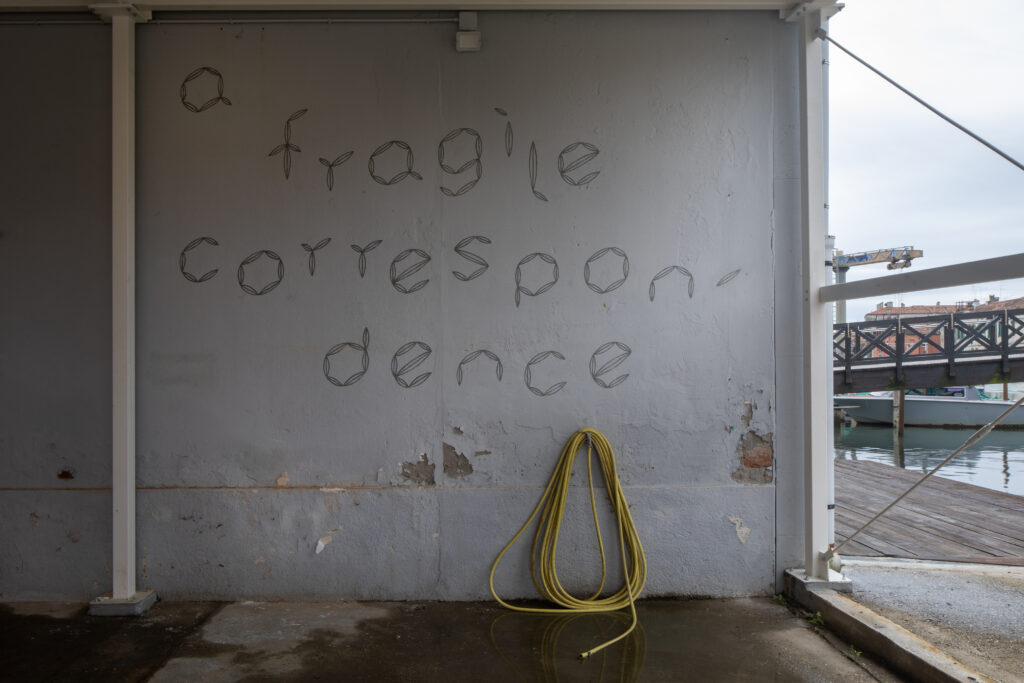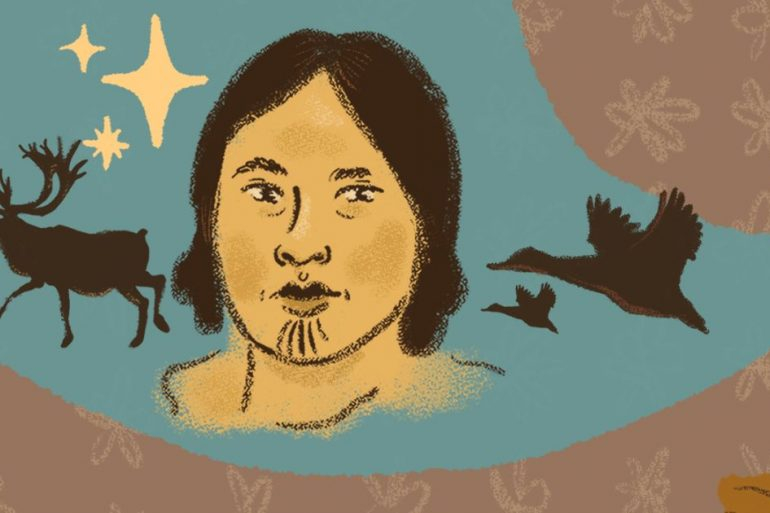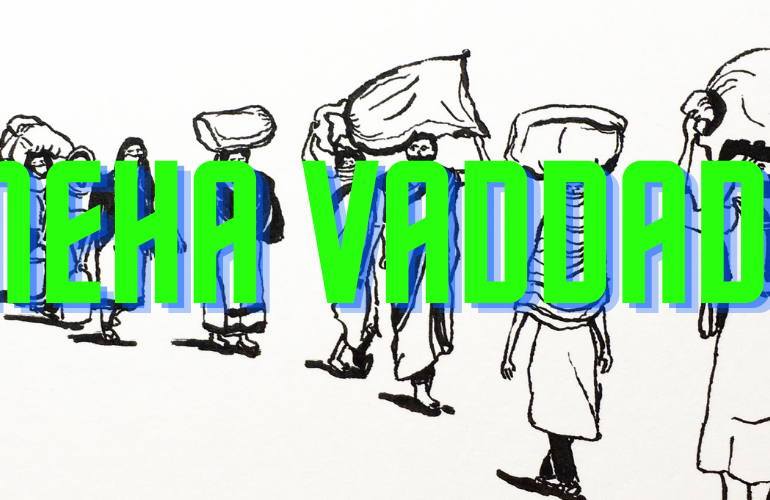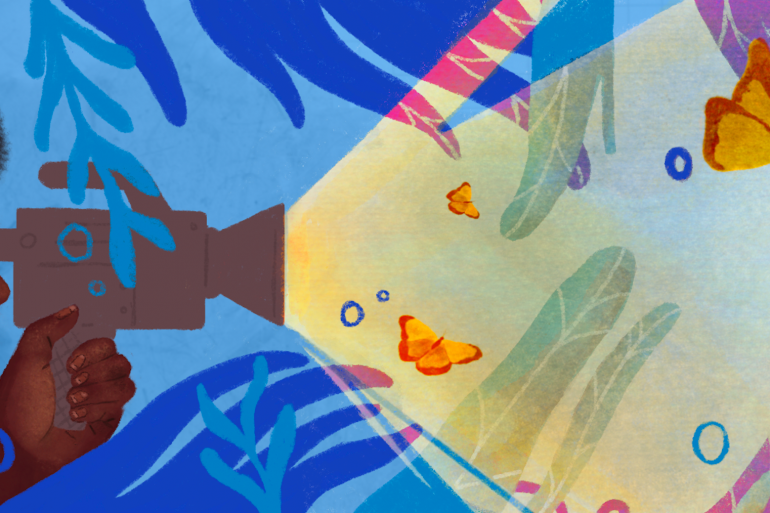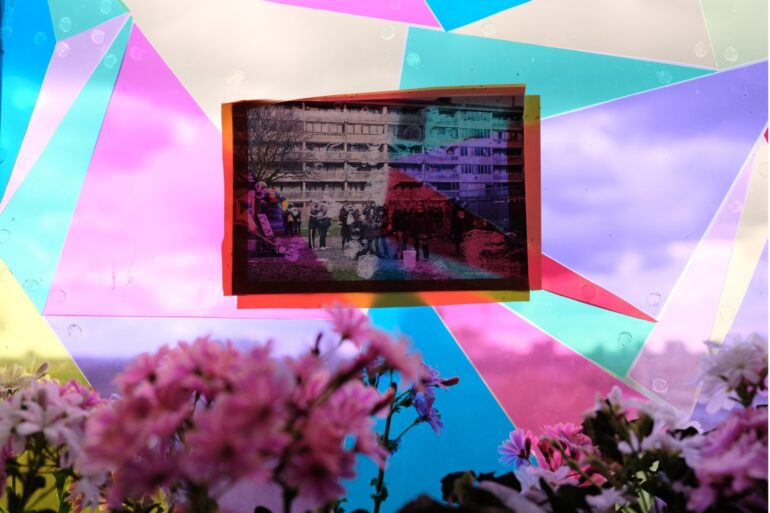“Architects should consider themselves facilitators,” says Alyesha Choudhury, co-founder of /other, a collective of POC architects that centre the marginalised individual within architectural discourse. We’re sat chatting at the exhibition they have co-curated for Scotland-Venice’s contribution to the Venice Biennale, A Fragile Correspondence.
A Fragile Correspondence is the culmination of ten months of investigation into three places across Scotland, and asks what happens if architects situate their practice within socio-ecological systems. If we start with a deep understanding about the landscapes and cultures that make up a place, how might that change architects’ responses to it? Could architects better respond to the needs of people in the process?
The space is calm and quiet, opening onto the canals of Venice. Water laps at the docks and boats chug by. It’s incredibly peaceful, the rooms spilling with artefacts and creative experiments from a network of architects, community groups, creative ethnologists and artists from across the diverse ecosystems that make up Scotland. Souvenirs of Scottish landscapes breathe Venetian air. The tagline – Highlands, Islands and Lowlands – reflects a collective unpicking of how diversity defines a nation and proposes new approaches where architects work in dialogue with the land and people rather than simply extracting from it.
“The architecture biennale allows you to present radical ideas or new perspectives, and with our collective being born out of frustration with traditional architecture… we had some ideas,” she laughs.
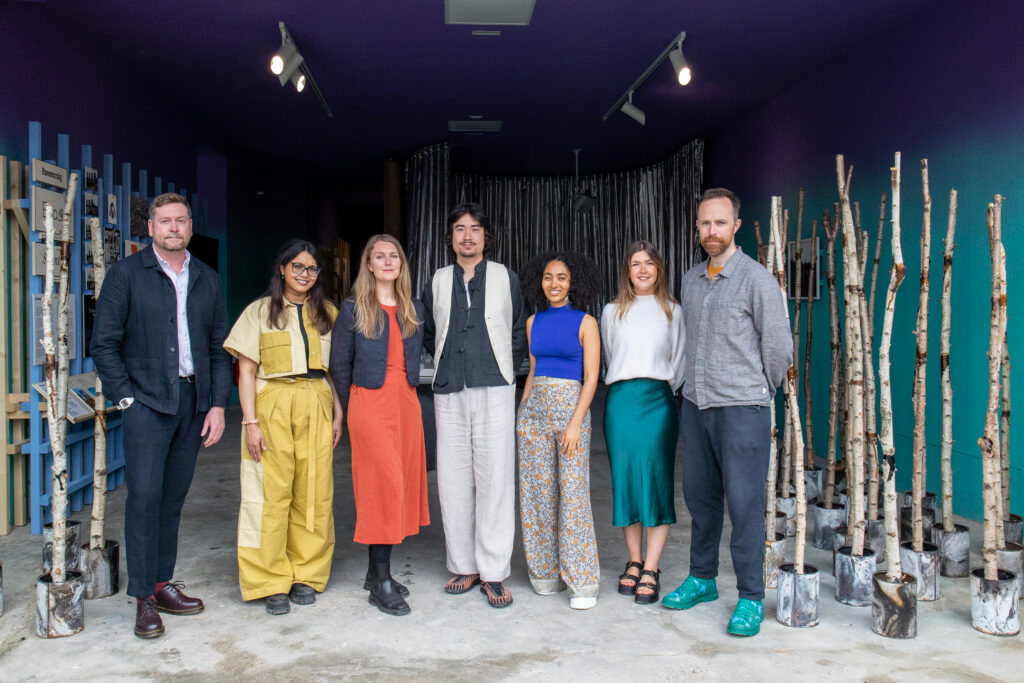
Andy Summers, Alyesha Choudhury, Kristina Enberg, Carl C.Z. Jonsson, Mia Pinder-Hussein, Amy McEwan and Neil McGuire.
Please note that team members Aoife Nolan and Alissar Riachi are not in this photo.
Representing each collective:
Neil McGuire and Andy Summers for the Architecture Fringe,
Kristina Enberg, Amy McEwan, Aoife Nolan, Alissar Riachi for ism magazine,
and Alyesha Choudhury, Carl C.Z. Jonsson and Mia Pinder-Hussein for /other.
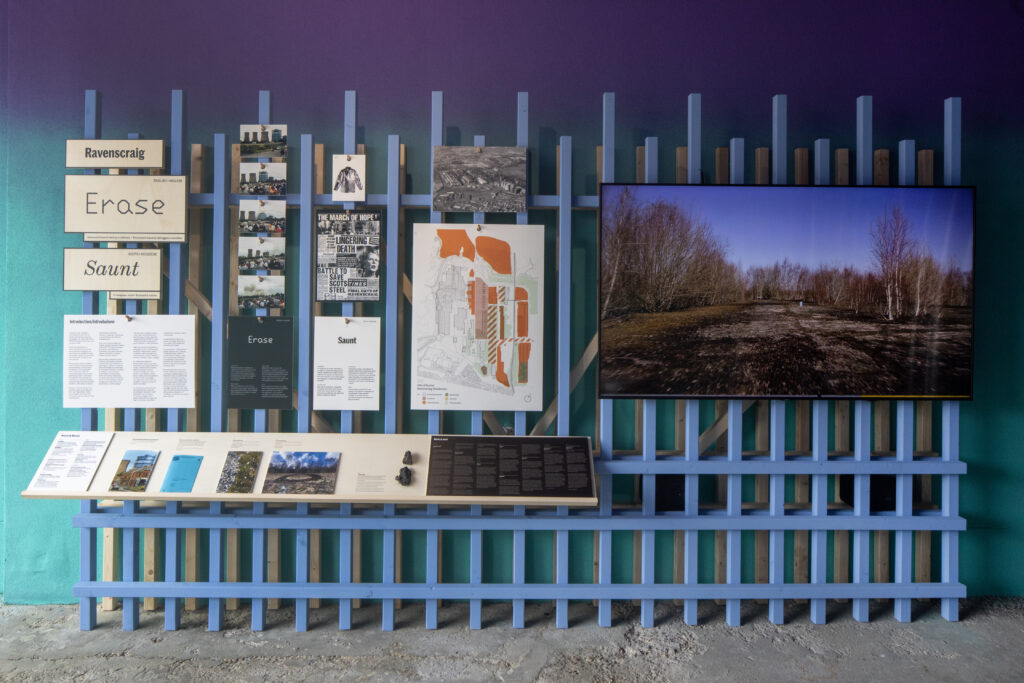
Architecture as collaboration
Architecture is a key practice that can help us tackle the intersecting crises of social inequality and climate change. With the built environment contributing over 39% of global energy related carbon emissions and millions of people in the UK living in poor quality housing, its clear architecture is both a problem, and also must be part of the solution.
In order for this to happen, there must be synergy between architect and landscape. Yet how architecture is taught has been widely criticised as structured for competition not collaboration. You are taught to design for communities that don’t exist, making co-development with the people that will ultimately use your design impossible. This lack of engagement then translated to real communities.
Alyesha reflects on her course teaching.“We’d go to certain areas of Glasgow with our course, and it was insane how these straight, white, male lecturers would talk about these communities with no empathy, just a list of facts and figures and so many assumptions,” she says. Separation from each other and from the communities they’re supposed to serve sees architects repeating the same errors.
Exasperated by this individualism in traditional architectural practice, /other and their co-conspirators set about designing an exhibition which put community and collectivism at the centre – aiming for diversity in curation to capture the multifacetedness of Scotland’s identity. A Fragile Correspondence defines architecture as so much more than buildings, but people, place, language, culture, and nature.
With only ten months to bring it together, the level of co-production for the exhibition was ambitious. The curatorial team is made up of /other, ISM (an independent architecture publication based in Glasgow) and Architecture Fringe (a more established festival of design and the built environment). Together, they tapped into their networks across the country.
“It’s been many layers of collaboration because we are just so frustrated when architects position themselves as ‘knowing everything’ – we are so aware we don’t and wanted to both design the exhibition in conversation with many people, but also create a space where people can continue that discussion,” Alyesha explains.
In response to the lack of engagement with social issues and absence of empathy so often seen in architecture curriculums, A Fragile Correspondence was designed iteratively, in conversation with local artists at the three sites they were working on Loch Ness (Highlands), Orkney (Islands) and Ravenscraig (Lowlands). Simply put: “Architecture is about people at the end of the day, and this current system doesn’t put people at the centre.”
Architecture must understand cultural history
“When it came to conceptualising the project, we tried to think about what makes Scotland different… and topographically, Scotland is very different from the UK,” Asheya says. “You have the central industrial belt, the cities, and further north the most insane and beautiful landscapes. The stories of these landscapes are so varied, and these are what make up Scotland.”
In exploring these diverse landscapes, the collectives found commonalities of native languages being intrinsically tied to the ecologies and communities – a catalyst for having more open discussions around architecture.
“The ideas of land and language are so universal – you don’t need an architecture degree to engage and have thoughts or critiques,” reflects Alyesha. In each place, the curatorial team worked with locals to unpick what language could reveal about these rich landscapes and histories.
In the exhibition, each landscape is mapped out through a native language and associated word. Working with creative ethnologists and translators in Loch Ness, the team were inspired by the Gaelic word “cothromachadh,” which broadly translates to a balance between humans and nature. The show explores the multiple ways of being lived out on Loch Ness, Scotland’s most famous landscape, revealing a complex reality of extraction, from the times of the highland clearances to the mono-cropped forests of today.
Local artists Mairi McFaydens audio exhibit explains the history of this place – its exploitation by global forces and how the people have proposed new ways of being in harmony with the land. The Highlands suffer from land ownership concentrated in the hands of very few, with recent research showing how wealth derived from the enslavement of peoples was used to buy up huge swathes of land for economic development and expulsion of local peoples. Forested land is being sold at a rapid rate through private finance as part of the broken and deeply unethical carbon market, where nurturing monocropped land becomes a profitable get-out-of-jail free card for the globe’s biggest polluters.
In this sense, Loch Ness perfectly encaptures how globalised forces of extraction and exploitation affect and erase local cultures and biodiversity. But interestingly, Loch Ness is also home to the earliest community buy-out of forest area in Scotland in 1998. The Abriachan Forest is owned by a community trust who pioneered new models of land ownership beyond capitalist logic. Here, the people live in harmony with the land, nurturing its biodiversity and educating kids in forest schools: cothromachdah in practice.
Generations of this community have lived in the forest, with place names on maps derived from Gaelic folklore. “From working closely with Gaelic community translators, it was clear that if we stop caring about the languages, we’d lose so much Scottish culture and history. The landscapes are older than us, they have survived many life cycles of humans and greed,” Alyesha explains. “The biggest thing we’ve learned is that architecture must respect the land, to work in balance rather than simply extract.”
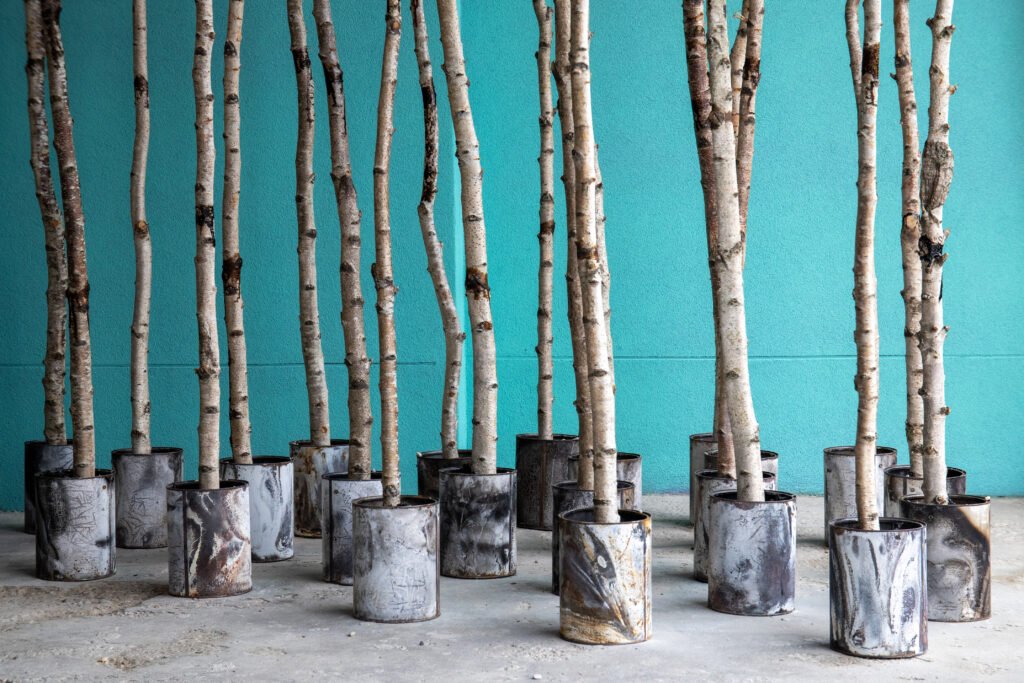
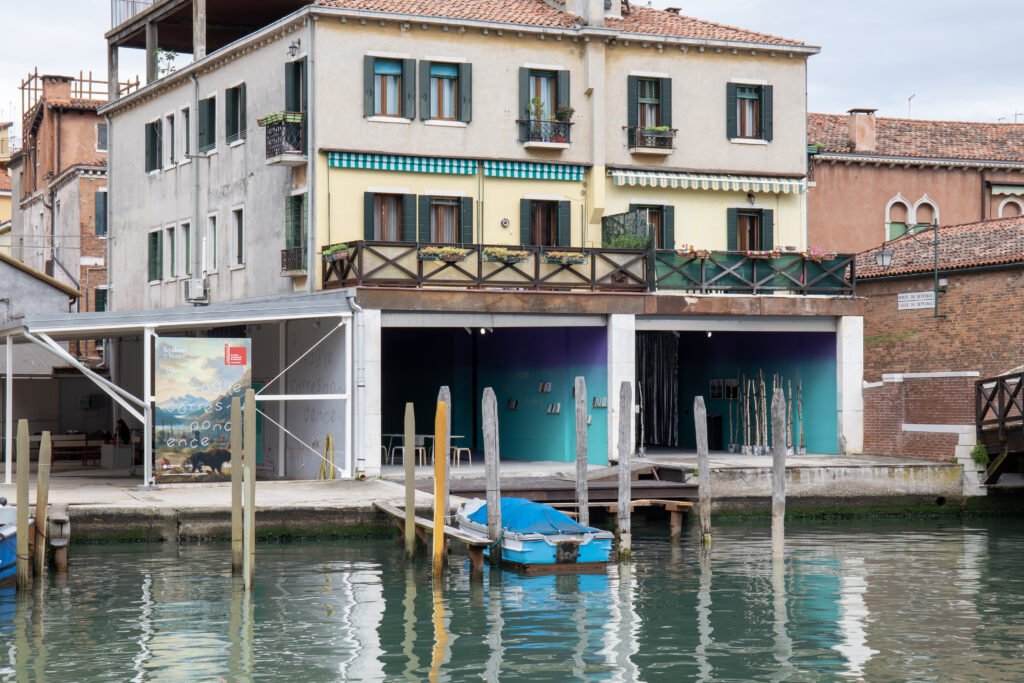
Architecture embedded in socio-ecological systems
In Orkney, the native language of Norn is a mixture of Scot with influences from Scandinavia, once headquarters for viking pirates due its proximity to Norway. Norway then annexed the islands causing an influx of Norwegian settlers for hundreds of years. An archipelago off the northeastern coast of Scotland, Orkney is famed for its rugged natural beauty, rich archeological sites and ability to watch the aurora borealis on the shortest day of the year.
“The land and the people of Orkney are resilient. Self-sustaining. They are proud of their ability to adapt to extremely harsh and changing climates,” says Alyesha. With Norn marking the complex histories of multiple cultures coming together, Orkney embodies a Scotland which is both hardy and outward-facing. “They don’t necessarily consider themselves Scottish, they call it ‘down south’.” How might architects acknowledge cultural pluralism and learn from Orkney’s ability to adapt with changing climates?
Subscribe to shado's weekly newsletter
Exclusive event news, job and creative opportunities, first access to tickets and – just in case you missed them – our picks of the week, from inside shado and out.

Until 30 years ago, Ravenscraig, the final location, was the site of a vast factory complex and steel mill. Once known as ‘steelopolis,’ nature has reclaimed the industrial landscape. “There is a whole new landscape! Pioneer and birch trees have flourished in a short time. It’s almost post-apocalyptic – because you have the remnants of human industry which shapes how the moss and trees grow. History cannot be fully erased.” Demolition of this site has made Ravenscraig the largest brownfield site in Europe, primed with potential if architects and leadership learn from past mistakes.
It tells a familiar story of industrial decline, where communities built around industry were failed and thrown into poverty. With the closure of Ravenscraig leading to 770 job losses, memories of sickness and death of loved ones working in the plants haunt the place. Environmental injustice in practice, where the health of low-income communities is sacrificed to fuel global industrial production.
How might architects follow nature’s suit, and reclaim the land without forgetting its history? How could it be designed to work for communities which have been failed countless times? How can you develop a town’s economy and built environment while protecting their health and well-being? Architects and town planners must learn from the past to design for the future.
Architects as facilitators
A Fragile Correspondence opens these questions to the biennale, inviting the public to contribute words from their cultural language that describe a place without direct English translation. After quickly running out of cards, visitors started jotting down scribbles and contributions on the table. “It’s so cool that you just put a pen on a table and people will have something to offer from their culture,” Alyesha remarks. “Language isn’t a container or a hard divide, but actually a way to share and learn new ways of understanding the world.”
Local artists, architects and community members have contributed archive and contemporary maps, imagery, printed materials and artefacts to create walls exploring each place with depth. Responses to these words bring materials from the landscape to Venice, alongside sculptures, moving image and installations to reflect aspects of the various Scottish languages, stories and landscapes.
A Fragile Correspondence provokes a radical repositioning of architecture, a decolonial pedagogy focused on rooting architecture in relation to cultural history, land and language. This approach celebrates Scotland as a unique jigsaw of histories and ecosystems which architects can learn from. As Alyesha says, architects must be facilitators – they have prestigious training and skills that not all people can access, and therefore must offer up those skills to the community to co-design a better future informed by the past. Let’s move past solo practitioners, but understand architecture as one tool in our collective box that can build something better – this time, in harmony with the local land and people, rather than extracting from them. Instead of designing for, architects must start from a place of designing with: the land, the culture, the people, and the ecosystems in mind.
What can you do?
- Support the Abriachan Forest Trust and the work of community woodland here: Get Involved
- To learn about practitioners Decolonising Architecture, follow this instagram account: Decolonise Architecture (@decolonisearchitecture) • Instagram photos and videos
- If you’re in Venice, check out the Scotland-Venice exhibition: A Fragile Correspondence – Scotland + Venice
- Keep up to date via Facebook, Twitter and Instagram
- To keep up /others upcoming work, follow here: /other (@slash_other) / X
- Read this article about the Venice Biennale: Venice Architecture Biennale: how radical can an architectural fair be? – Shado Magazine
